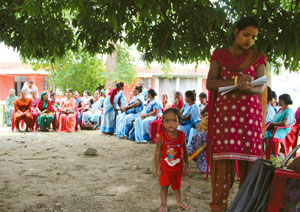 PICS: BHRIKUTI RAI Name Please: A representative from a local mother's group takes down the names of the participants at the social audit. |
The locals have all gathered under the shade of a large mango tree in the premises of Chaumala Primary Health Care Centre (PHCC) and are engaged in intense discussion about their pressing health concerns.
It is called 'social audit day', a programme introduced by the Ministry of Health and Population (MoHP) in 2009 to strengthen local participation in decision-making, accountability and transparency in health services. It provides a platform for healthcare workers to build trust and discuss issues concerning the community with the public and VDC officials.
 |
Local participation in decision-making has helped health providers identify and respond more urgently to local needs. "The audit is making it easier for us to identify problems, as well as come up with solutions through the full participation of the community," says Shova Mani Bhatta, an Auxiliary Nurse Midwife at the Chaumala primary health centre.
 |
At Chaumala, locals complain about being mistreated by health professionals which discourages them from visiting the centre. Kaushila BK, a Dalit woman, says she was sent away with her pregnant daughter-in-law because of lack of facilities. "How are we going to take care of ourselves when government health facilities meant for poor people treat us like cattle?" BK asked the health centre officials. Other participants, many of them mothers with toddlers in tow, nod in agreement.
 |
The budget and expenditure of the Primary Health Care Centre is also made public during the audit. "We want to make the workings of the Centre as transparent as possible and gain the community's trust," says Panday.
By promoting good governance at health centres, the project helps fill the vacuum created by the absence of elected VDC representatives. In 2011, the District Health Office with support of the German aid agency, GiZ, started the social audit programme in 16 villages in Doti district.
"As we had decided during last year's audit we conducted regular awareness programmes on cholera prevention and cut down on staff leave so that we could closely monitor cholera related cases," says Bhakta Singh BK of Durgamandau Health Post. Durgamandau VDC in Doti is one of the many areas where commitments made during SA have helped supply drugs on time and counter cholera outbreak.
 |
Back in Chaumala the discussion gets livelier as people start voicing their opinions with greater confidence. The meeting concludes after health managers promise improved health services. As participants walk away from the health centre, it is clear the participatory approach works.
But locals are also worried that health officials always have an excuse when things don't work: lack of budget, qualified personnel or facilities. And there are always promises that are never kept.
Sabitri Aryal stays till the end, and tells us with a sigh: "I hope the commitments made today won't just remain on paper and we get to see improvements."
Read also:
A nation's health, EDITORIAL
Selecting medical school applicants with district backgrounds and who have worked their way up as paramedics improves chances of doctors serving in rural Nepal
In an ailing state, ANURAG ACHARYA
If this is the state of city hospitals, imagine what it is like in rural areas
Why some doctors stay and others go away, KUNDA DIXIT
New study finds factors that make Nepali doctors more likely to practice in rural Nepal instead of moving to Kathmandu or migrating abroad
See also:
Born to live, ROBIN GIRI in DANG
Housewives help save thousands of lives in rural Nepal
Nepal's real heroines, NARESH NEWAR in DADELDHURA
Female community health volunteers bring medical care to the weak and sick in remote areas
Remote control
Achham district has one of the worst health parameters in Nepal, largely because of low literacy, poor drinking water and lack of basic health facilities. It has the highest incidence of HIV in Nepal, and one in every five children is severely malnourished.
But in the last three years, the government's neglected Bayalpata Hospital has been managed by a US-based group who set up Nyaya Health. Established by two doctors from the Harvard Medical School, it runs Bayalpata Hospital under a unique public-private partnership with the Ministry of Health.
The 15-bed hospital has a staff of 54, many of them volunteers, and provide free, quality healthcare to the people of Achham and even neighbouring districts. With a new surgical ward in place, Bayalpata has already made a dent in Achham's poor health statistics, especially by enabling C-sections to be performed for complicated pregnancies.
"The hospital is god-sent for us," says Kare Bhul, 58, of Chandika VDC who was diagnosed with HIV three years ago and has been receiving anti-retroviral treatment here. "Had it not been for Bayalpata Hospital many of us would have died by now."
Working in a remote district like Achham is demanding for the team at Bayalpata, and the major challenge is recruiting and retaining doctors to stay. "Given the remoteness the application for many crucial positions including physicians and surgeons hasn't been robust," says Gregory Karelas of Nyaya Health Nepal.
Nevertheless Karelas is hopeful that this unique model of reaching to the poorest of the poor with quality healthcare will be replicated in other areas of Nepal and attract motivated doctors to serve in rural areas.
Bhrikuti Rai in Achham
Read also:
Why some doctors stay and others go away
New study finds factors that make Nepali doctors more likely to practice in rural Nepal instead of moving to Kathmandu or migrating abroad
See also:
Every day is Mother's Day, RUMA RAJBHANDARI in ACHHAM
Throughout the world, mothers are strong, but Nepali mothers are in another league altogether
Resurrection Achham, PAAVAN MATHEMA
Nyaya Health is making the right to health a reality for the people of Achham


